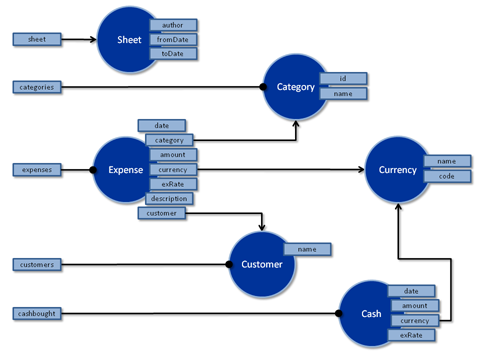
ExTra: The Expenses Tracker
Object Model
expenses - the collection of expense items belonging to this expense sheet. Each item has the expected fields like the date, description and amount as well as links to the currency, category and customer/project. categories - a collection of all the categories referenced by the expense sheet. Iterating through this collection allows you to build summaries split by category. customers - a collection of all the customers/projects referenced by the expense sheet. Iterating through this collection allows you to build summaries split by customer/project. cashbought - a collection of all the cash bought referenced by the expense sheet. Iterating through this collection allows you to build a summary of exchange rates used. Fields are referenced using dot notation, so
In order to iterate through a collection of objects, we need to define an area to represent a template row, which will be replicated for each object in the collection. This is done using a comment and specifies the collection to iterate through, the name to give to the currency object and the last cell in the row (the comment being placed on the first cell). For example:
Will iterate through the collection of expense items, assinging the name
Finally we need to define the complete area of the sheet and this is done by placing a comment in cell A1 with the text: jx:area(lastCell="L23")
There is much more that can be done with JXLS, including creating formulas for each row and creating multi-sheet workbooks. To read more about this, see the documentation for JXLS here.
|
|||||||||
|
|
||||||||
|
|
||||||||
